Chapter 5: General Site and Building Elements
Required Number [§208]
This guide explains requirements in the ADA Standards for parking.
Accessible parking spaces are required for each parking facility on a site, such as lots and garages. Requirements apply equally to public and employee or restricted parking. On sites with multiple parking facilities, the minimum number of accessible spaces must be calculated separately for each parking facility instead of on the combined total of parking spaces provided on the site. At least one of every 6 accessible spaces, or fraction of 6, in each parking facility must be sized to accommodate vans.
Accessible Parking on a Site
Minimum Number of Accessible Parking Spaces [§208.2]
| Parking Facility Total | Minimum Number of Accessible Spaces | ||
| Standard | Van* |
Total (Standard + Van) |
|
| 1 - 25 | 0 | 1 | 1 |
| 26 – 50 | 1 | 1 | 2 |
| 51 – 75 | 2 | 1 | 3 |
| 76 – 100 | 3 | 1 | 4 |
| 101 – 150 | 4 | 1 | 5 |
| 151 - 200 | 5 | 1 | 6 |
| 201 – 300 | 5 | 2 | 7 |
| 301 – 400 | 6 | 2 | 8 |
| 401 – 500 | 7 | 2 | 9 |
| 501 – 550 | 9 | 2 | 11** |
| 551 – 600 | 10 | 2 | 12** |
| 601 – 650 | 10 | 3 | 13** |
| 651 – 700 | 11 | 3 | 14** |
| 701 – 750 | 12 | 3 | 15** |
| 751 – 800 | 13 | 3 | 16** |
| 801 – 850 | 14 | 3 | 17** |
| 851 – 900 | 15 | 3 | 18** |
| 901 – 950 | 15 | 4 | 19** |
| 951 – 1000 | 16 | 4 | 20** |
| 1001 –1100 | 17 | 4 | 21*** |
| 1101 – 1200 | 18 | 4 | 22*** |
| 1201 – 1300 | 19 | 4 | 23*** |
| 1301 – 1400 | 20 | 4 | 24*** |
| 1401 – 1500 | 20 | 5 | 25*** |
| 1501 – 1600 | 21 | 5 | 26*** |
| 1601 – 1700 | 22 | 5 | 27*** |
| 1701 – 1800 | 23 | 5 | 28*** |
| 1801 – 1900 | 24 | 5 | 29*** |
| 1901 – 2000 | 25 | 5 | 30*** |
| 2001 and over | (*** - *) | * | *** |
* at least 1 of every 6 accessible spaces or fraction of 6
** 501 - 1000: 2% of total
*** 1001 and over: 20 + 1 for each 100 or fraction thereof over 1000
Valet Parking
Accessible spaces are required in parking facilities with valet parking because vehicles specially equipped for persons with disabilities may not be easily used by others. Further, valet parking may not be available at all hours a parking facility is open. An accessible passenger loading zone also is required at facilities with valet parking (§209.4).
Alterations and Additions
Refreshing existing striping in place for several spaces or filling potholes is typically considered normal maintenance, not an alteration.
Accessible spaces are required where parking facilities are altered or added. The term ‘alterations’ includes resurfacing of vehicular ways (§106.5). Resurfacing or resealing and projects that add new parking spaces constitute alterations (or additions) and must include accessible spaces as required in the scoping table. Normal maintenance, such as pothole repair, surface patching, or repainting in place existing striping for a few spaces, is not considered an alteration except where it affects a facility’s usability.
Location [§208.3]
In some cases, achieving the shortest accessible route will require locating accessible spaces closest to an entrance ramp instead of the entrance doors.
Where parking serves multiple entrances to a facility, accessible spaces must be dispersed among accessible entrances. (If the number of accessible entrances exceeds the number of accessible spaces, additional accessible spaces are not required). Accessible parking spaces must be located on the shortest accessible route to an accessible entrance, relative to other spaces in the same parking facility. A maximum travel distance is not specified in the Standards.
Accessible spaces required for one parking facility can be located in another if doing so results in substantially equal or better access in terms of travel distance to an accessible entrance, parking fee, or user conveniences such as protection from weather, better security and lighting. The minimum number must still be determined separately for each parking facility. Locating accessible spaces required for a parking structure in a surface lot often will not qualify for this exception because such a location typically offers less convenience, security, and protection from the elements.
Multiple Parking Facilities on a Site
Scoping and dispersion requirements ensure access to all parking facilities on a site, including large sites with many lots and garages, such as airports, shopping malls, and campuses. The term “parking facility” encompasses parking lots, as well as garages, decks, and other parking structures. The minimum number of accessible parking spaces must be determined separately for each parking facility.
Parking facilities are to be treated separately for scoping purposes if they are either:
-
structurally different (e.g., surface lot versus parking garage or deck);
-
dedicated to, and separately serve, different facilities on a site;
-
segmented and separated by guard rails, fencing, or barriers, particularly where they serve different users; or
-
separated by streets or roadways (as opposed to drive aisles on a site).
Surface lots that are contiguous or that are segmented by landscaping or drive aisles (i.e., vehicular passageways located within parking areas), but not streets or roadways, typically can be treated as a single parking facility.
Example Site: Shopping Mall
Recommendation: Where spaces within the same parking facility are assigned or restricted to specific user groups, consider calculating the minimum number of spaces separately for each type of parking or proportionately dispersing accessible spaces based on the overall total across each type of parking to ensure sufficient access for all users. Note that greater dispersion may be required under the Department of Justice’s ADA regulations governing policies and practices to ensure sufficient access for all users.
Garage Parking
The Standards apply to parking garages, including those provided below grade. At sites that also include surface lots, a garage is treated as a separate parking facility for scoping purposes.
Multi-Level Parking Garage Not Serving a Particular Facility
Accessible spaces, including van spaces, must be located so that they provide the same level of protection and security as other spaces in the garage. Locating accessible spaces required for a garage on the exterior is not usually acceptable.
Mechanical Access Parking Garages
Accessible parking spaces are not required in mechanical access parking garages where lifts are used to stack vehicles. However, such facilities must provide at least one accessible passenger loading zone at vehicle drop-off and pick-up areas so that people with disabilities can transfer from vehicles (§209.5).
Hospital Outpatient Facilities [§208.2.1]
The Standards require a higher level of accessible parking at hospital outpatient facilities. At least 10% of patient and visitor parking spaces that serve such facilities must comply. This applies to those units in hospitals that provide regular or continuing medical treatment without overnight stay. Other types of medical facilities not located in hospitals, including doctors’ offices and independent clinics, are not subject to this requirement but to the regular scoping table.
Accessible Parking at Outpatient Facilities in Hospitals
Rehabilitation and Outpatient Physical Therapy Facilities [§208.2.2]
At least 20% of patient and visitor parking spaces must be accessible at outpatient physical therapy facilities (including those not located at hospitals) and at rehabilitation facilities that specialize in treating conditions that affect mobility. Conditions affecting mobility include:
-
those involving the use of mobility aids and devices (braces, canes, crutches, prosthetic devices, wheelchairs, or powered mobility aids);
-
arthritic, neurological, or orthopedic conditions that severely limit one's ability to walk;
-
respiratory diseases and other conditions which may require the use of portable oxygen; or
-
cardiac and other conditions that impose substantial limitations on one’s mobility.
Rehabilitation facilities that provide, but that do not specialize in, services or treatment for persons with mobility impairments, such as general rehabilitative therapy centers, are not subject to the 20% requirement. In mixed-use facilities, the 20% may be applied only to the portion of spaces that are determined to serve the types of rehabilitation or outpatient therapy facilities covered by this provision.
Residential Facilities [§208.2.3, §208.3.2]
Accessible parking at residential facilities is based on the ratio of parking spaces to dwelling units.
Parking at Residential Facilities
Accessible Parking Spaces [§502]
Requirements for accessible parking spaces address the size and marking of regular and van spaces and access aisles, surfaces, vertical clearance at van spaces, identification, and connecting accessible routes.
Accessible Routes and Access Aisles
Recommendation: Configure accessible routes so that they run in front of, instead of behind, parking spaces.
Accessible Parking Space
Van Accessible Parking Spaces [§502.1 - 502.5]
At least one space for every 6 or fraction of 6 accessible spaces must be van accessible. Van spaces provide an additional 3 feet of width to accommodate vehicles equipped with ramps or lifts. This extra space can be added to either the parking space or to the access aisle. A wider access aisle saves space since two spaces can share one aisle, but wider spaces can help prevent misuse of the access aisle as a parking space.
Van Space: Wider Parking Space
Recommendation: Sizing all accessible spaces (or access aisles) for van accessibility provides greater convenience and helps ensure that van spaces remain available for those who need them. Where a van space and regular accessible space share an aisle, it is advisable to have the access aisle serve the van space on the passenger side (as is required where van spaces are angled) since backing into spaces can be more difficult with vans.
Van Space: Wider Access Aisle
Angled Van Spaces
As with regular accessible spaces, van accessible spaces can share a common access aisle. However, where van spaces are angled, an access aisle is required for each space on the passenger side (§502.3.4). This is the side from which ramps and lifts typically deploy.
Recommendation: Where standard (non-van) accessible spaces are angled or otherwise restrict entry to one direction only, providing one access aisle for each accessible space (or on both sides where only one accessible space is provided) will offer greater usability by accommodating access on either side. Otherwise, consider designing accessible spaces to permit both front-in and back-in parking.
Vertical Clearance [§502.5]
A 98” minimum vertical clearance is required for van parking spaces/ access aisles and the vehicle route to these spaces from an entrance and from these spaces to an exit. Van spaces can be grouped on one level of parking structures.
Recommendation: Signs at garage entrances that indicate vertical clearances and the location of van spaces are advisable.
Pay Stations
Pay stations and other elements that serve accessible parking spaces must comply with requirements for operable parts (§309) and be served by an accessible route. Require-ments [sic] for operable parts cover clear floor space, operating characteristics, and location within accessible reach ranges. Operable parts that are used from inside vehicles, such as garage ticket dispensers at vehicle entry, are not required to comply with the Standards. However, under DOJ’s ADA regulations, policies or practices must be in place to accommodate persons with disabilities who are unable to use such devices.
Requirements for operable parts include:
Identification [§216.5, §502.6]
Accessible spaces must be identified by signs with the International Symbol of Accessibility (ISA) (§703.7.2.1). Signs identifying van spaces must include the term “van accessible.” This designation is informative and does not restrict use of such spaces to van users only. No other text or content is required by the Standards.
Signs must be at least 60” high measured to the bottom edge so that they are visible while vehicles are parked in a space. Signs can be on posts, or where feasible, on walls or suspended from ceilings (an 80” minimum headroom clearance is required at signs suspended above circulation paths (§307.4)). ISA designations on the parking surface, even if required by a state or local government, cannot substitute for above-ground signs that remain visible at all times.
State or local codes and regulations may address other sign characteristics, including size, color, and additional content, such as “reserved” or violation fines, but the ADA Standards do not.
Exceptions
If a total of 4 or fewer parking spaces (inaccessible and accessible) is provided on a site, the required accessible space does not have to be identified by a sign (i.e., reserved exclusively for use of people with disabilities) (§216.5, Ex. 1). However, all other requirements for spaces, including access aisles, still apply.
At residential facilities, identification of accessible spaces is not required where spaces are assigned to specific dwelling units (§216.5, Ex. 2).
Electric Vehicle Charging Stations
The Standards do not include specific provisions for electric vehicle (EV) charging stations. However, it is advisable to address access to EV charging stations so that they are usable by people with disabilities. If provided, accessible spaces at EV charging stations cannot count toward the minimum number of accessible car and van parking spaces required in a parking facility.
Common Questions
Must the minimum number of spaces be determined separately for each parking facility on a site or can it be based on the collective total of spaces provided on a site?
The minimum number of accessible parking spaces, including van accessible spaces, must be calculated separately for each parking facility on a site. Spaces required for one parking facility can be provided in another where doing so results in equal or greater access and convenience for users, but the required number must still be calculated separately for each parking facility.
Is accessible parking required on sites where no parking is intended?
No, the ADA Standards require accessible spaces only where parking is provided. They do not require accessible spaces where parking is not provided at all. Most local and state codes and regulations address the amount of parking required for a site.
Are accessible spaces required in employee parking lots?
Yes, the requirements for accessible parking spaces apply equally to employee parking facilities and are not limited to visitor parking. Where a parking facility contains parking spaces for visitors and spaces reserved for employees only, it is important that sufficient access is provided to both types of spaces. In this case, it is advisable to calculate the minimum number separately for each type of space as though they were separate parking facilities, but this is not required if they are both located in the same parking lot or garage. Both accessible visitor and employee spaces must be on the shortest accessible route to an accessible entrance.
Are accessible spaces required in temporary parking lots and in unpaved lots, such as gravel or grass lots?
Yes, the ADA Standards apply to both permanent and temporary facilities, including parking facilities (§201.3). In all parking facilities, including gravel or grass lots, parking spaces and access aisles must be marked and have firm, stable, and slip resistant surfaces as specified for accessible ground and floor surfaces (§302).
Is resurfacing of a lot considered an alteration?
According to the definition of "alteration," normal maintenance is not considered an alteration unless it affects a facility’s usability. For example, if a lot is to be resurfaced or its plan reconfigured, accessible spaces must be provided. However, work that is primarily maintenance, such as surface patching, does not trigger a requirement for accessible spaces. When the work is not considered an alteration, providing accessible spaces is advisable where sufficient accessible parking is lacking and may be necessary in meeting obligations for program access by government entities and barrier removal by public accommodations as required by DOJ’s regulations.
Are accessible spaces required for tractor trailers at rest stops and other facilities?
No, the Standards exempt those spaces used exclusively for trucks, as well as buses, other delivery vehicles, law enforcement vehicles, or vehicular impound.
Is compliance required for parking spaces designed specifically for recreational vehicles such as motor homes and camping or boating trailers?
Spaces designed for recreational vehicles (RVs) and trailers are not exempt from coverage, but the Standards do not include technical provisions specific to these spaces. If RV or trailer spaces are located in parking facilities with car and van parking spaces, scoping should be applied separately to both types which will permit accessible RV or trailer spaces to be located among other RV or trailer spaces so long as they are on the shortest accessible route to facility entrances among such spaces. Access aisles serving accessible spaces must be as long as the vehicle space they serve.
The ABA Standards, which apply to federally funded sites, provide requirements for outdoor developed areas on federal lands such as camping and picnic facilities that include provisions for RV parking and pull-up spaces. They can be consulted as a reference in addressing access to RV parking on non-federal sites, including those subject to the ADA. The ABA Standards address access to RV and other parking spaces at camping and picnic units and pull-up spaces at dump stations and cover space width (minimum 20’, or 16’ in the case of a second adjoining space) and utility and sewage hook-ups (§1011 and §1012).
Are accessible parking spaces required on a site where valet service is provided but vehicles are parked off site, such as in a public parking garage or on public streets?
Parking facilities with valet parking must provide accessible parking spaces to allow self-parking by people with disabilities (and must also provide an accessible passenger loading zone (§209.4)). This applies where parking spaces are provided on the same site as the valet parking service. However, if valet parking service is provided on a site without any parking spaces, accessible parking spaces are not required on the site (but policies and practices to accommodate people with disabilities must be in place under the Department of Justice’s ADA regulations). Public garages and other parking facilities subject to the Standards must comply and provide accessible parking spaces in any case. If a parking garage does not provide valet parking, or if valet parking service is provided off site by a different entity that parks vehicles in the garage, an accessible passenger loading zone is not required at the garage.
Do the Standards specify a maximum travel distance between parking spaces and facility entrances?
No. The Standards require that accessible parking spaces be on the shortest accessible route to an accessible entrance, but they do not specify a maximum travel distance, nor do they require that parking be installed where none is planned (e.g., directly in front of an entrance).
Can accessible spaces required for one parking facility be located in another one instead?
Accessible spaces required for one parking facility can be located in a different parking facility on the site if it results in substantially equal or greater access and convenience for users. (§208.3.1, Ex. 2). The term “user convenience” applies to factors such as protection from the weather, security, lighting, and comparative maintenance.
Can van spaces required for a parking garage be located in a surface lot instead?
No. Accessible parking, including van spaces, required for one parking facility can be located in another parking facility only where it results in substantially equal or greater access and convenience for users. Open lots do not provide the same level of protection, security, and lighting as garage parking.
Is vertical access required to all levels of a parking garage?
It depends. The Standards require that an accessible route connect each story in “multi-story” facilities but include certain exceptions based on the number of stories or the square footage per floor (§206.2.3). As defined in the Standards, a “story” contains space for “human occupancy” (i.e., equipped with ventilation, light, and means of egress). Levels of open parking structures that do not contain occupiable space are not considered “stories” under the Standards. However, an accessible route must connect all accessible parking spaces to the accessible entrances they serve as well as any other elements or spaces required to be accessible. Vertical access must be provided as necessary to address any changes in level along these required accessible routes. For example, in underground parking garages, elevators or, where feasible, pedestrian ramps, are necessary to provide an accessible route from parking levels with accessible spaces to the facility they serve.
Are accessible spaces required on all levels of a multi-level parking structure?
It depends. If a parking facility has entrances and exits on one level only, standard and van accessible spaces are required on that level so that they are on the shortest accessible route to the entrance/exit. However, where a parking facility has entrances/exits or direct connections to an adjacent building on multiple levels, standard accessible spaces must be dispersed among accessible entrances on different levels, but van spaces can be grouped on one level under all conditions (§208.3.1, Ex. 1).
Can accessible routes run behind other parking spaces?
The ADA Standards require that an accessible route connect parking space access aisles to the accessible entrance they serve but they do not specifically prohibit the accessible route from running behind parking spaces. However, it is recommended that accessible routes be configured so that they run in front of parking spaces for greater safety.
Are bollards, poles, columns, or other elements permitted within the marked area of access aisles?
No elements, including bollards, columns, or poles, can encroach into the defined area of access aisles. (The width of spaces and aisles is measured to the centerline of markings but can include the full line width where there is no adjacent parking space or aisle).
Must accessible routes or crossings be marked?
No. The ADA Standards require accessible parking spaces and access aisles to be marked, but they do not require accessible routes, including portions crossing vehicular ways, to be marked.
How are parking spaces and access aisles to be marked?
The ADA Standards do not specify the method or color of parking space and access aisle markings. State or local codes and regulations may specify such markings. It is important that access aisles be marked in a manner that discourages parking in them, especially those that are 8 feet wide at van spaces.
What are the requirements for the size and color of signs?
The ADA Standards require accessible spaces to be designated by the International Symbol of Accessibility. In addition, van spaces must be labeled by the term “van accessible.” The Standards do not specify sign color, size, or other characteristics. Signs may be subject to additional specifications under applicable state or local requirements or the Manual on Uniform Traffic Control Devices published by the Federal Highway Administration.
Can surface decals substitute for post- or wall-mounted signs?
No, the Standards require signs identifying accessible parking spaces that are at least 60” high measured to the bottom edge of the sign so that they are visible when a vehicle is parked in the space. Surface decals or other identifying features may be required by local or state codes and can be provided in addition to, but not in place of, signs required by the ADA Standards.
Is front-in only or angled parking prohibited for accessible parking spaces?
No, the ADA Standards do not prohibit front-in only, back-in only, or angled parking spaces. However, where van spaces are angled, the Standards require the access aisle to be located on the passenger side which is the side where vehicle ramps and lifts are typically deployed. Since users pull in or back in depending on which side the access aisle is needed, it is advisable to design both regular and van accessible spaces so that they can be entered in either direction. Otherwise, consider providing one access aisle at each regular accessible space instead of allowing two spaces to share an aisle so that access is available on both sides.
Can accessible spaces be parallel instead of perpendicular?
The Standards do not specifically require that accessible spaces be perpendicular instead of parallel, but perpendicular parking spaces are preferred at facilities located on sites because most allow users to park facing in or out depending on the side that the access aisle is needed. If accessible parking spaces at facilities located on sites (as opposed to those located along public streets) are parallel, they must fully comply with all applicable requirements, including those for access aisles and for van spaces.
Must van accessible spaces be restricted to van use?
No. The required "van-accessible" designation is informative, not restrictive, in identifying those spaces that are better suited for van use and does not restrict the use of spaces to vans only. State or local codes and regulations may require additional verbiage, but the ADA Standards do not. Additional content on van designation signs can recommend that car drivers not use the space unless no other accessible parking space is available.
Do the surface requirements, including those for maximum slope (1:48), apply to all portions of a parking lot?
No, the surface criteria apply only to accessible parking spaces, access aisles, and accessible routes, including those serving other elements or spaces besides parking spaces. Transitions to these areas from other portions of lots should be smooth to prevent tripping hazards.
Required Compliance [§209]
Where passenger loading zones are provided, at least one accessible passenger loading zone is required in every continuous 100 linear feet of loading zone or fraction thereof. Compliance is required only where areas are specifically designed or designated for passenger loading, such as those at airports, many hotels, and convention centers.
At least 1 accessible passenger loading zone is required in every continuous 100 linear feet (or fraction) of passenger loading zone space.
Required Passenger Loading Zones
Accessible passenger loading zones must be provided at these facilities, whether or not passenger loading zones are planned:
-
licensed medical care and licensed long term care facilities where the period of stay exceeds 24 hours (located at an accessible entrance) (§209.3);
-
parking facilities where valet parking service is provided (§209.4); and
-
mechanical access parking garages (located at vehicle pick-up and drop-off areas) (§209.5)
Accessible Passenger Loading Zones [§503]
Requirements for accessible passenger loading zones address vehicle pull-up spaces and access aisles, including their dimensions, surfacing, and vertical clearance.
Accessible Passenger Loading Zone
Bus Loading Areas and On-Street Bus Stops [§209.2.2 and §209.2.3]
Loading zones designed for buses that provide general or special service, including charter service, to the public on a regular and continuing basis are required to comply with provisions for bus boarding and alighting areas (§810.2) in the transportation facility section of the Standards. This includes bus service provided by public transit agencies and other state or local government entities, excluding public school transportation (referred to as “designated public transportation” in ADA regulations issued by the Department of Transportation (DOT)). It also applies to those serving tour, charter, and shuttle buses operated by private entities (referred to as “specified public transportation” in DOT’s regulations). On-street bus stops also must comply with requirements in §810.2 to the maximum extent practicable.
Common Questions
Are accessible passenger loading zones required on sites where no passenger loading zone is intended?
Accessible passenger loading zones are required at these sites whether or not passenger loading zones are planned: parking facilities that provide valet parking, licensed medical care and long term care facilities where the period of stay exceeds 24 hours, and mechanical access parking garages. At all other facilities, the requirements apply only where passenger loading zones are provided.
What constitutes a “passenger loading zone”?
Only those areas that are specifically designed or designated for passenger loading are considered “passenger loading zones” under the Standards. This includes those passenger drop-off or pick-up areas commonly found at airports, convention centers, schools, and many hotel entrances that have design features, signs, or markings indicating passenger loading zones. At other locations, compliance is not required even if passenger loading may occasionally occur, but is not specifically intended or reflected in the design.
What distinguishes passenger loading zones from bus loading zones?
Requirements for passenger loading zones (§209.2.1) apply to any passenger loading areas except those that exclusively serve buses providing designated or specified public transportation as defined by DOT’s ADA regulations, including charter service, which are subject to criteria for bus loading zones (§209.2.2) or on-street-bus stops (§209.2.3). For example, at an airport, passenger drop-off and pick-up areas serving cars, taxis, limousines, vans, and other vehicles are treated as passenger loading zones, while stops exclusively serving public transit buses, hotel buses, and other types of buses providing designated or specified public transportation must meet criteria for bus loading zones.
If a passenger loading area serves cars and vans, as well as buses, must the provisions for passenger loading zones and bus loading zones both be satisfied?
No, provisions for bus loading zones (§810.2) apply only to on-street bus stops and those bus loading zones that exclusively serve designated or specified public transportation vehicles. All other types of loading zones for passengers must meet criteria for passenger loading zones (§503). Where regular passenger loading zones are designed to serve buses in addition to other types of vehicles not used to provide public transportation, they remain subject to criteria in §503, although applying the requirements for bus loading zones in §810.2 as well is advisable, but not required.
Is a compliant passenger loading zone required where valet parking is provided?
An accessible passenger loading zone is required where parking facilities provide valet parking services (§209.4). Also, an accessible passenger loading zone is required where passenger loading zones are provided and specifically designed or designated, such as many hotel entrances, whether or not valet parking service is provided (§209.2.1). If a site provides valet parking service but contains no parking facilities (i.e., vehicles are parked on a different site), then a compliant passenger loading zone is required only where a passenger loading zone is provided. Here are several examples of how these requirements apply:
-
if a parking garage (or other parking facility) provides valet parking service, an accessible passenger loading zone is required whether or not a passenger loading zone is planned;
-
if a restaurant or hotel provides a designed or designated passenger loading zone, an accessible passenger loading zone is required whether or not valet parking service is provided;
-
if a restaurant or hotel provides valet parking service but does not have a parking facility on the same site (i.e., vehicles are parked off site in a public garage or on public streets) and does not have a designed or designated passenger loading zone, then a compliant passenger loading zone is not required. (Note that policies and practices must be in place under the Department of Justice’s ADA regulations so that the valet parking service accommodates people with disabilities).
Must the access aisle be flush with the pull-up space?
Yes, the access aisle at accessible passenger loading zones must be at the same level as the vehicle pull-up space it serves.
Can curb ramps overlap access aisles?
No, access aisles, as well as vehicle pull-up spaces, cannot have changes in level other than slopes not exceeding 1:48.
How are accessible passenger loading zone aisles to be marked?
The Standards require access aisles to be marked so as to discourage parking in them, but they do not specify how markings are to be provided. State or local codes and regulations may specify such markings. Vehicle pull-up spaces are not required to be marked.
Are accessible passenger loading zones required to be labeled by the International Symbol of Accessibility?
No, accessible passenger loading zones are not required to be identified by the International Symbol of Accessibility.
Required Compliance [§210]
Interior and exterior stairs that are part of a required means of egress must meet the Standards. Compliance is required for all stairs on required egress routes, including those comprised of a single riser. The Standards do not apply to stairways that are not part of a required means of egress nor to alternating tread devices and “ship’s ladders.” The Standards exempt aisle stairs in assembly areas, stairs in non-public areas of detention and correctional facilities, and stairs of play components.
Alterations
In alterations, stairs between levels that are connected by an accessible route (e.g., ramp or elevator) are not required to meet the Standards, but handrails must comply when stairs that are part of a means of egress are altered (§210.1, Ex. 2).
Stairways [§504]
Requirements for stairways address treads and risers, surfaces, nosings, and handrails.
Recommendation: Providing visual contrast (light-on-dark or dark-on-light) on the top and bottom steps that is approximately 2 inches wide and located either on nosings or at the leading edges of treads is helpful for people with low vision.
Handrails [§504.6, §505]
Handrails are required on both sides of stairs and must be continuous within the full length of each stair flight. Inside handrails on switchback or dogleg stairs must be continuous.
Stairway Handrails
Recommendation: In facilities that primarily serve children, a second set of stairway handrails 28” high maximum above stair nosings is advisable. A vertical clearance 9” minimum between upper and lower handrails will help prevent entrapment.
Handrail Extensions [§505.10]
Handrail extensions at the top and bottom must return to walls, guards, or floors and horizontal portions must comply as protruding objects. The length is measured to the start of the return radius.
Handrail Clearance and Cross Section [§505.5, §505.7]
Surface requirements and clearances facilitate a power grip along the length of handrails. Handrails can have circular or non-circular cross-sections, but must have rounded edges. The gripping surface and adjacent surfaces must be free of abrasive or sharp elements. Wall-mounted handrails with leading edges higher than 27” cannot protrude more than 4½” into circulation paths (§307.2).
Circular Cross Section and Clearance
Non-Circular Cross Section and Clearance
Recommendation: Projecting objects above handrails can impact their usability. Keep wall surfaces above handrails free of any protrusions.
Escalators
The ADA Standards address escalators in rail and fixed guideway stations (§810.9) but not those provided in other types of facilities. Escalators must have a clear width of at least 32” and meet specific provisions in the ASME A17.1 Safety Code for Elevators and Escalators. The referenced ASME criteria require steps to be demarcated by yellow lines 2” wide maximum along the back and sides (§6.1.3.5.6) and specify at least 2, but no more than 4, flat steps at escalator entrances and exits (§6.1.3.6.5).
Recommendation: Apply the requirements for escalators in rail and fixed guideway stations to escalators provided in other types of facilities.
Common Questions
Are stairs that are not part of means of egress required to comply with the Standards?
No, interior or exterior stairs that are not part of a required means of egress do not have to meet the Standards.
Are exterior stairs required to comply with the Standards?
The Standards apply to both exterior and interior stairs that are part of a required means of egress. This includes exterior stairs that are part of exit discharge (i.e., the path from an exit to a public way such as a street or alley).
Is there a minimum number of risers a stairway must have for it to be covered?
No, the Standards apply to any stairs that are part of a means of egress regardless of the number of risers.
Are stairs in residential dwelling units covered by the Standards required to comply?
Yes, stairs that are part of a means of egress must comply in mobility accessible residential dwelling units covered by the Standards. Egress stairs of residential facilities that are located outside individual dwelling units also must comply.
Can stair treads and risers be perforated?
Stair treads must meet requirements for floor or ground surfaces which specify that surface openings not allow passage of a sphere more than ½ inch in diameter (§302.3). Risers cannot be open, but perforations or openings in riser surfaces that prohibit passage of a sphere not more than ½ inch in diameter are acceptable.
Can handrail extensions wrap or turn?
Handrail extensions must be in the same direction as the stair flight, but continuous handrails can wrap at the inside turn of switchback or dogleg stairways. In alterations where the required extension would project into circulation paths and pose a hazard, they can turn, wrap, or be shortened as necessary.
Can handrails overlap door maneuvering clearances?
No, door maneuvering clearances must be free of any overlapping objects, even those providing knee and toe clearance, which can interfere with maneuvering at doors and doorways. However, door maneuvering clearances can be offset up to 8” from the face of the door or gate to accommodate wall thickness, casework, shelves, or other elements adjacent to doorways, including handrails. The door maneuvering clearance must be measured from the leading edge of such elements so that the full clearance is free of any obstruction.
Can handrails be attached to guard rails?
Yes, handrails can be installed on guard rails if all applicable requirements are met.
Is a center handrail required at wide stairways?
No, a center handrail at stairs is not required by the Standards. If a center handrail is provided, compliance with the handrail specifications, while advisable, is not required.
Is color contrast required for stair nosings?
Visual contrast on stair nosings or the leading edges of treads is helpful for people with low vision, but it is not required by the Standards except at escalators in rail and fixed guideway stations which must meet the ASME A17.1 Safety Code for Elevators and Escalators. The ASME A17.1 code requires escalator steps to be demarcated by yellow lines 2” wide maximum along the back and sides.
Can guards or collars be attached to handrails to prevent skateboard traffic?
No, handrail gripping surfaces at egress stairs subject to the Standards must be unobstructed on the top and sides and free of sharp or abrasive elements so that users can maintain a continuous grip along the full length (§505.6 and §505.8).


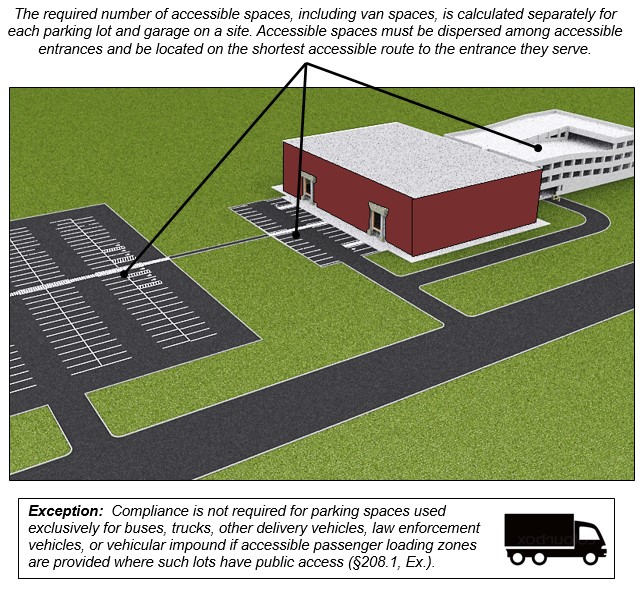

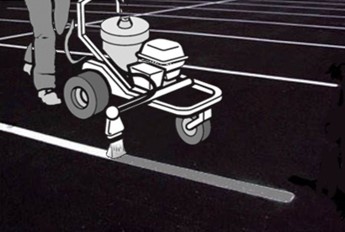
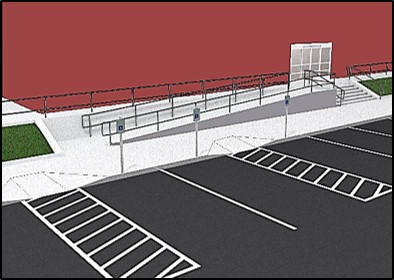
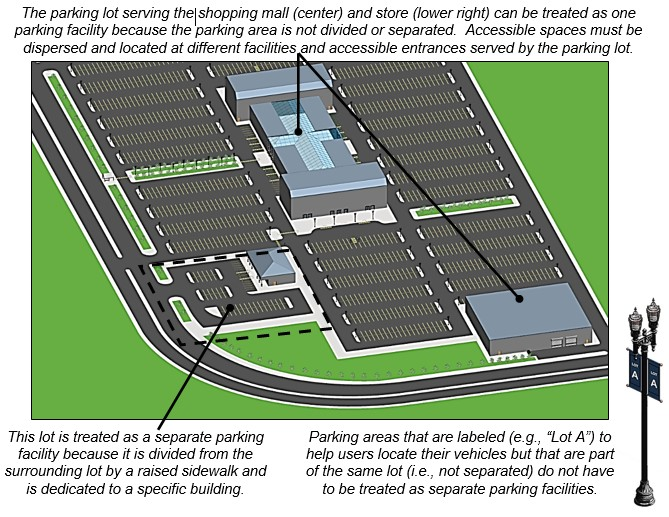

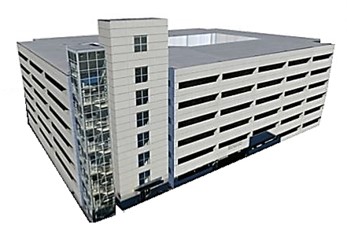
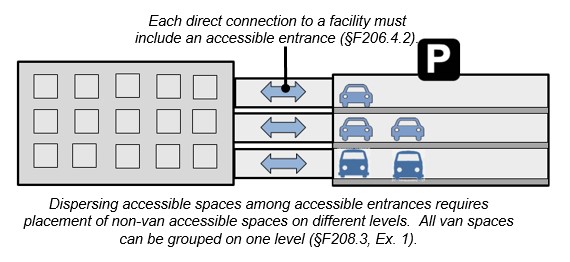

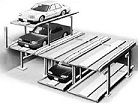
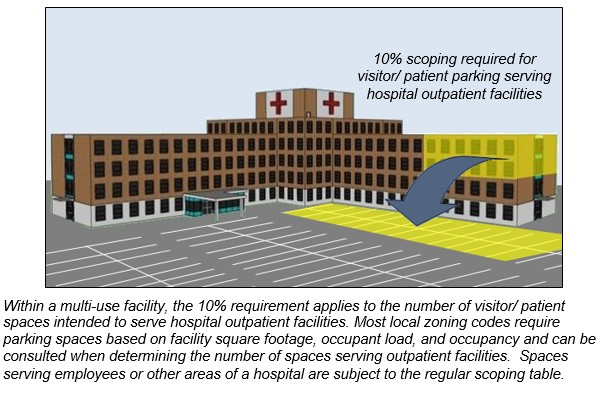

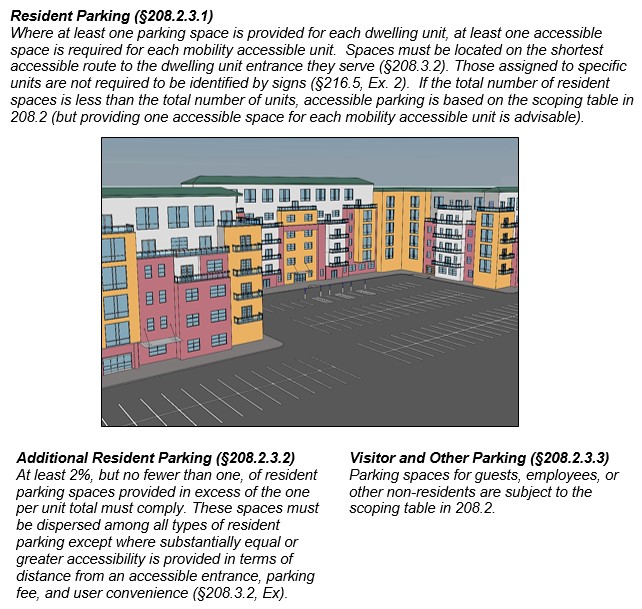
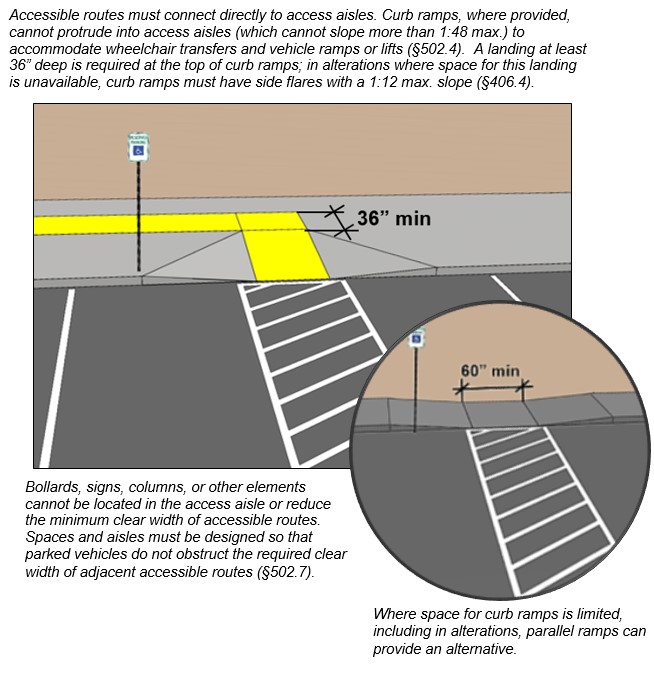

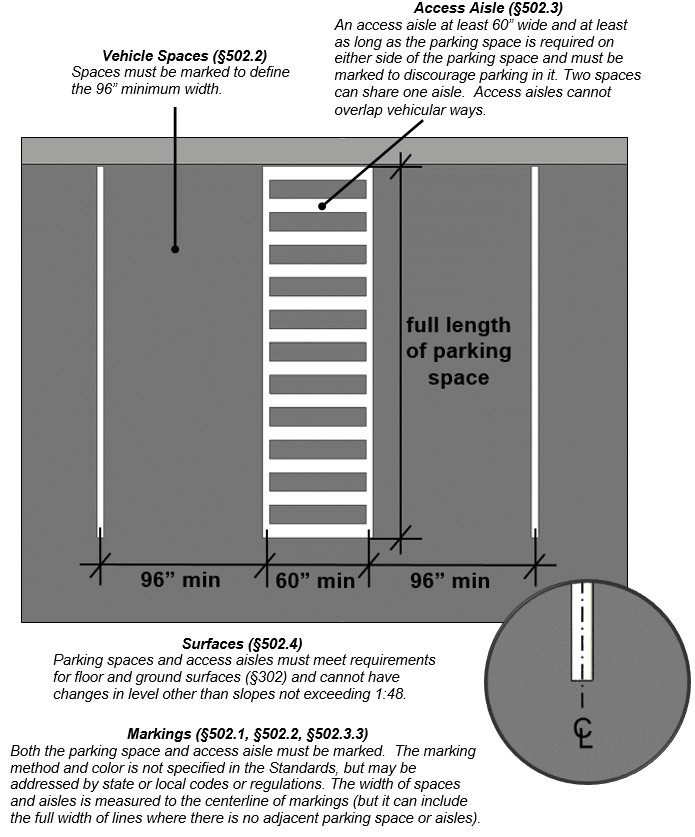
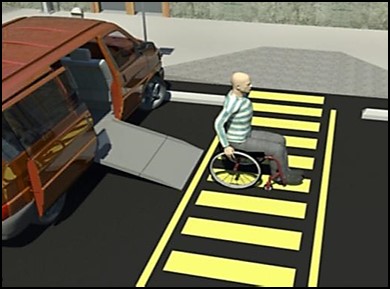
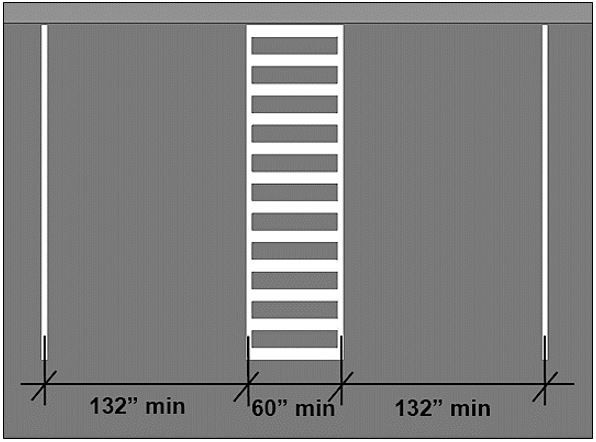

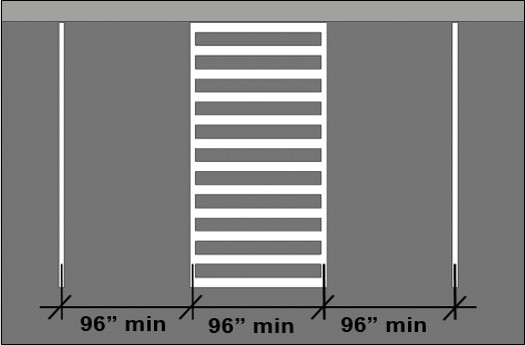
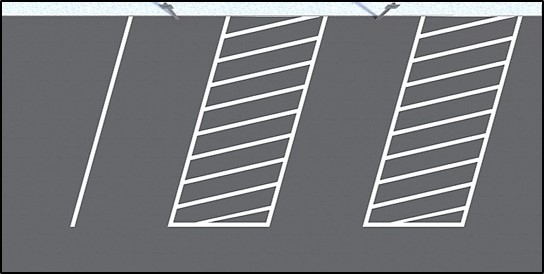

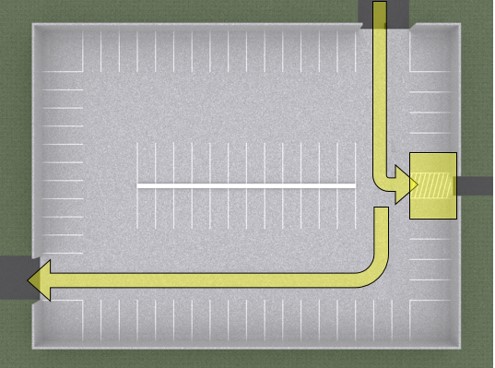

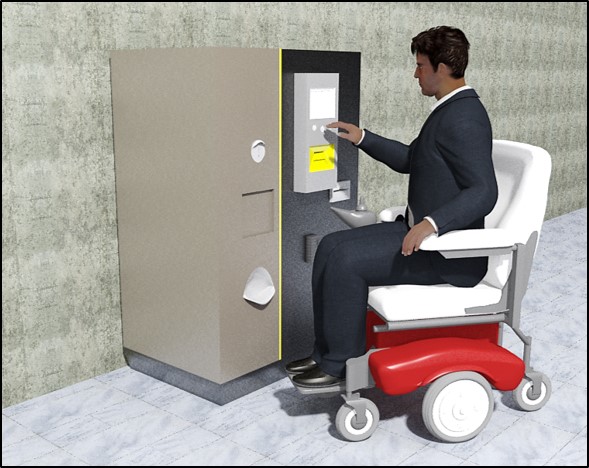
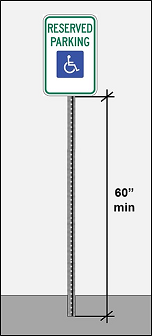

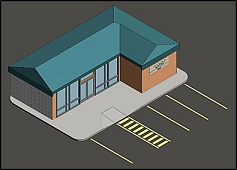


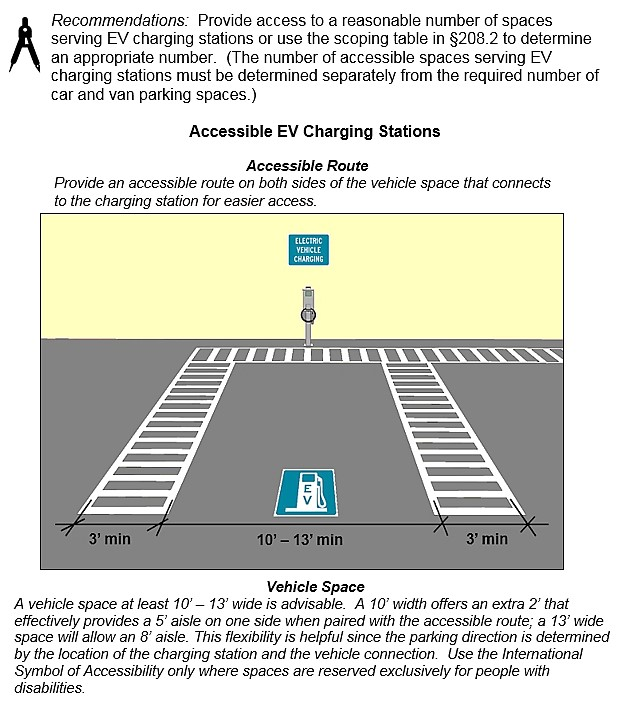


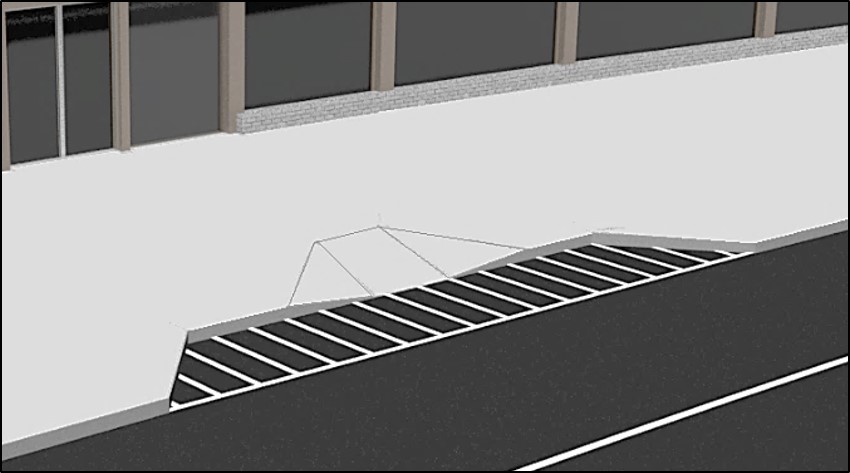

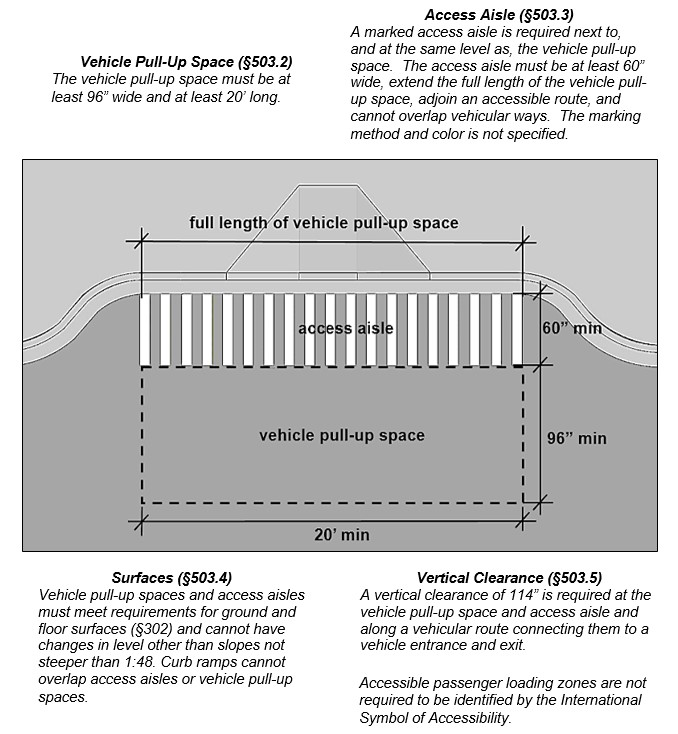


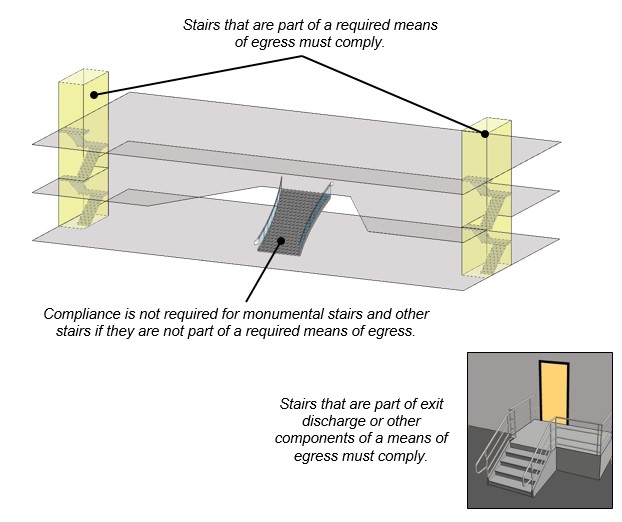
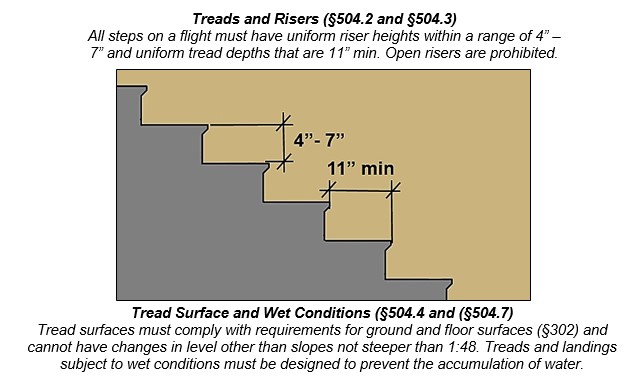
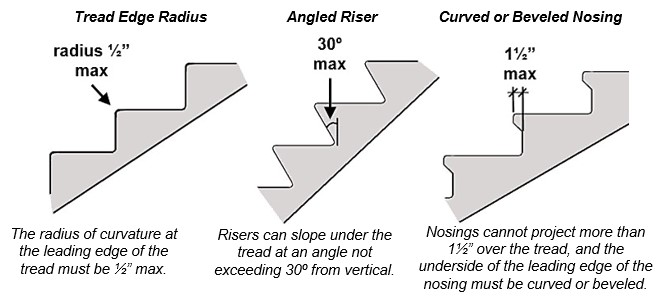

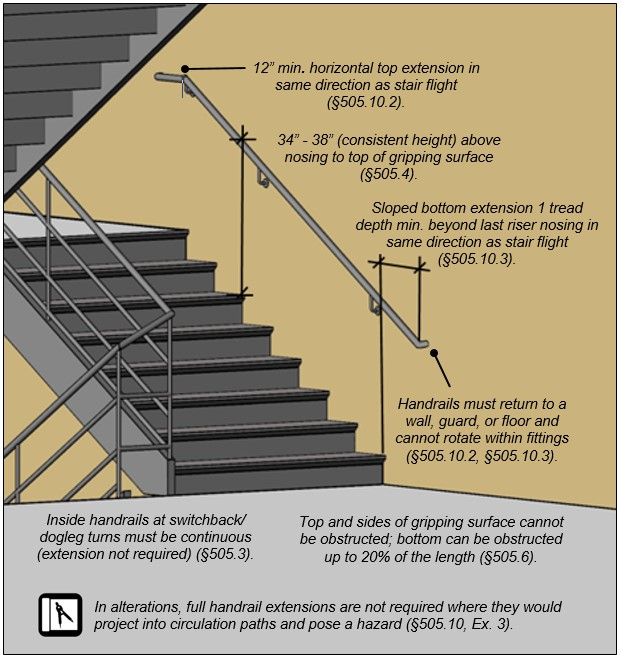

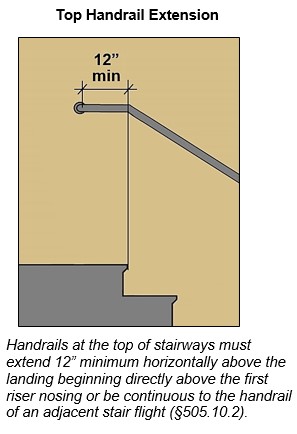
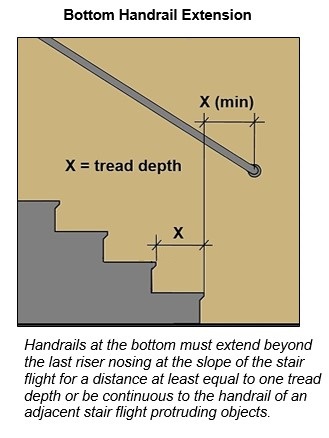
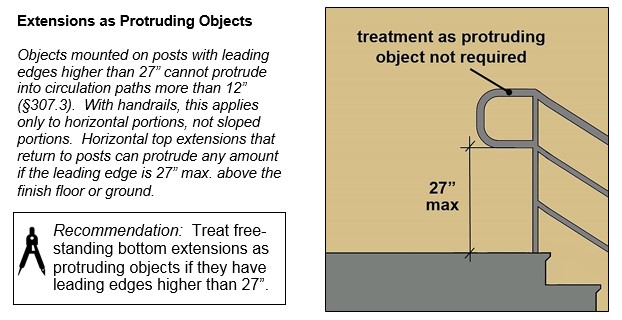
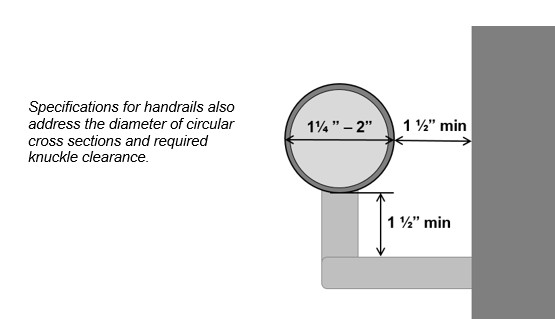
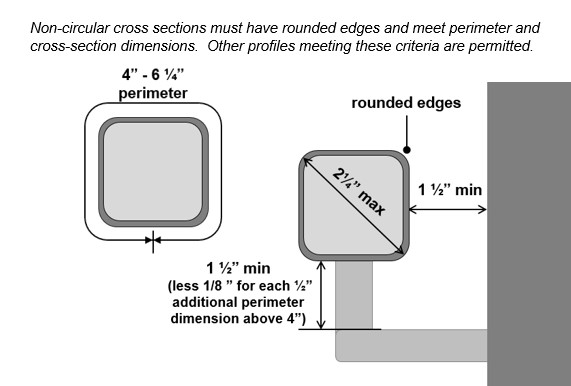




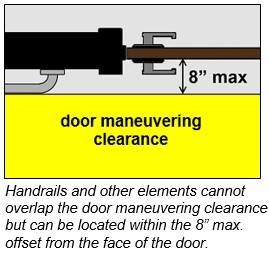
User Comments/Questions
Add Comment/Question